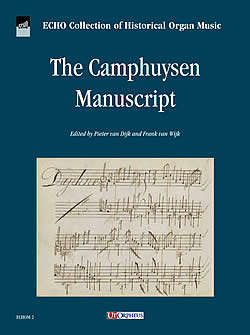Edited by Pieter van Dijk and Frank van Wijk
Published by Ut Orpheus ECHOM2 £43.95
Available from: www.utorpheus.com

This is the second volume in the new series ntitled ECHO collection of Historical Organ Music. It is the first complete modern edition of the late 17th century MS in the library of the university, Utrecht, known as the Camphuysen MS (a small selection was edited by Alan Curtis in an anthology of mss in 1961) since 21 of the 36 pieces it contains are based on melodies from the so-called Stichtelycke Rymen by Dirck Camphuysen 1586-1627, some being set more than once. The remaining pieces include nine based on Genevan Psalm melodies (Psalms 8, (two settings) 74, 146, 65, 116, 23, 100, 5) six of which close the Ms, two on Balletti by Gastoldi and four on secular tunes. The engraved title page is empty and the MS carries no mention of composer or date.
The Balletti by Gastoldi are two settings of Godt Schiep den Mens vol Eere, the first being a simple chordal setting with some quaver movement in the second half whereas the second setting comprises three verses increasing in elaboration with writing in quaver triplets in verse three. The four secular tunes include a simple setting of Blijtschap van mij vliedt with the melody in the right hand against chords, a similar setting of De Engelsche Fortuijn, also set by Byrd, Sweelinck and Scheidt, and a three verse setting of Daphne, also set by Farnaby, each verse increasing in virtuoso passagework in each hand. This is by far the longest and the most techinically demanding setting in the volume. One purely instrumental piece without any vocal models is the short setting of Brabantse dragonders Mars, with the melody in the right hand over two or three part chordal writing with a few quaver runs.
The 21 settings of melodies from the publication by Dirck Camphuysen are also mostly quite simple with the melody ornamented lightly over chords. All are quite short, with only Hoe ongelicjcken Lot covering two pages. Apart from Psalm 74, which is in quavers throughout the rh against crotchets and has the character of a verse-variation and the first setting of Psalm 8 which is in two voices with the melody in the bass beneath a treble in crotchets and quavers, the Psalm Melodies are chordal and are presented in minims and semibreves, three of them (Psalms 100, 5 and 8 second setting) being followed by a second verse which is in quavers. Comparison with the much earlier Psalm settings in the Susanne van Soldt MS will be profitable.
Almost all of the pieces have no key signature, and are in C,, Gm, D minor and A minor. No. 24 has two flats and is in C minor, nos. 20, 25 and 28 in G minor have one flat. These pieces sound well on domestic stringed keyboard instruments, and a performance on the chamber organ and regal was also likely; by using a variety of light stops and eschewing reeds and heavy Diapasons, the player can make these pieces sound as lively and fresh on the organ today as they were some 350 years ago. In only seven pieces is a split registration possible on one manual, and in only two pieces is there clearly a call for a short-octave instrument.
The edition opens with the general conventions adopted for the series, a short bibliography for the interested reader, followed by a detailed preface giving information about the origin and content of the MS, notation and performance options including ornaments - apart from the five bicinia, the pieces contain many single and double stroke ornament signs - as well as the policy on accidentals. The critical report gives comments on every piece including its origin and editorial amendments. The printing is extremely clear and carefully laid out so that there are no unmanageable page turns. A facsimile of each piece is included within the music text. Perhaps the overall contents are of greater interest to early music specialists wishing to learn more about domestic keyboard music written by Sweelinck’s successors, but the variations are valuable as teaching material and could be included in recitals.
